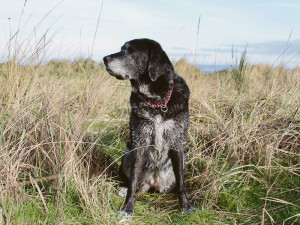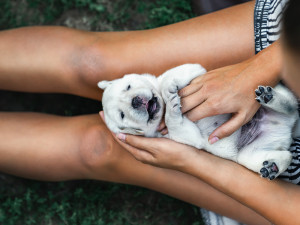5 Tips for Helping Your Dog with Degenerative Myelopathy
The disease inhibits your dog's ability to use their legs. One writer shares how the condition is diagnosed — and how you can help your dog stay mobile.

share article

Your pet wants you to read our newsletter. (Then give them a treat.)
When I first noticed my Boxer, Gus, dragging his back foot, I teased him about being lazy. At age 10, Gus was finally mellowing out after a decade of careening through life like a rodeo bull. Eventually, though, he began to drag that foot on our walks, and because we live in an urban, mostly paved area, all that friction began to wear down his nails and scrape the skin from his knuckles.
That was the first sign that Gus had degenerative myelopathy (DM). An insidious disease, degenerative myelopathy in dogs is a slowly progressing condition that affects the nerves of the spinal cord, cutting off communication between the brain and limbs. Over time, the affected dog will become paraplegic and eventually will be unable to stand. Here’s everything you need to know about degenerative myelopathy, plus tips for helping your dog stay mobile if they're diagnosed.
Symptoms of Degenerative Myelopathy in Dogs
Symptoms of degenerative myelopathy in dogs are often missed because they look similar to other conditions such as hip dysplasia, where the hip joint doesn't work properly. The most apparent sign of degenerative myelopathy is wobbly rear legs and paw dragging. The deterioration often progresses over several months. During that time, dogs with degenerative myelopathy will experience ataxia (impaired balance and coordination) in their rear legs, ultimately losing the ability to walk.
Older dogs, typically of large breeds including German Shepherds, Labrador Retrievers, Boxers, Corgis, Chesapeake Bay Retrievers, Bernese Mountain Dogs, Mastiffs, and Ridgebacks are most commonly affected by degenerative myelopathy.
When it comes to diagnosing degenerative myelopathy in dogs, a simple DNA test offered by the Orthopedic Foundation for Animalsopens in a new tab (OFA), requiring only a saliva swab, can help your vet determine whether your dog is a carrier or at-risk for the disease. An MRI of the spine is the gold standard diagnostic for DM, says neurology specialist Dr. Avril Arendse at MSPCA-Angell. With an MRI, veterinarians can rule out the possibility of hip dysplasia, disk disease, tumors or other neurological causes for the clinical signs.
Treatment for Degenerative Myelopathy in Dogs
Currently, there is no scientifically-proven, effective treatment for degenerative myelopathy. Veterinarians may be able to treat some related symptoms to relieve discomfort, but a healthy diet and plenty of exercise, including walking and swimming, are the main ways to keep dogs with the condition as mobile as possible. “Intensive physical rehabilitation and selected assistive equipment can extend a dog’s survival time by up to three years, versus six months to a year for dogs who do not receive therapy,” adds Best Friends Dog Rescue.
While this sounds like very bad news — and well, it kind of is — there are some silver linings: If your dog is diagnosed with degenerative myelopathy, rest assured they will experience very little pain. And just because mobility is a growing challenge for them, that doesn't mean you'll lose them sooner. You likely have plenty of days left together — possibly even years. And to make the best of them, you’ll need a strategy, as well as some new gear to compensate for your pup’s handicaps. Below is what helped Gus and me.
How to Care for a Dog With Degenerative Myelopathy
1. Purchase a Pair of Dog Boots
Search for “dog boots” on Amazon and you’ll find hundreds of choices. After many failed attempts (and a lot of wasted money), I finally figured out that for a dog with degenerative myelopathy, only two factors matter: boot security (so it will stay on despite being dragged repetitively) and durability (so it can withstand all the friction). A boot with a high, adjustable ankle section takes care of the first requirement, and flipping the boot upside down is my best advice for the second. I found that placing the boots sole-side-up didn’t affect Gus’s ability to walk in them, and it kept them from becoming a shredded mess after just a walk or two.
2. Invest in a Harness
Your dog will need rear-end support. Some people use a simple beach towel as a support sling for stairs and slippery flooring, but after a few false starts, I found a full-body harness (like this oneopens in a new tab) with a front handle near the shoulder and another near the hips to be the solution we needed. At first, it allowed me to assist Gus every now and then. Near the end of his life, his “butt handle,” as I took to calling it, was essential for helping him use the bathroom and picking him up quickly when he fell.
3. Find a Community
Studiesopens in a new tab show that physical therapy can more than quadruple the survival time in dogs with degenerative myelopathy. I can attest that after his weekly underwater treadmill sessions, Gus seemed a little stronger and more dexterous. But those appointments provided us with something even better — a team. Talking to the physical therapists each week made me feel less alone in dealing with Gus’s challenges, which can sometimes feel like a lot.
Another unexpected bonus of physical therapy was the veritable lending library of gear at our fingertips. After dogs with degenerative myelopathy pass, their humans often donate the boots and harnesses they’ve accumulated. Because of their generosity, we were able to try out different boots and slings, as well as borrow a wheelchair, which can cost hundreds of dollars for larger dogs.
4. Take Care of Yourself
In the last few months of Gus’s life, when his back legs had all but given out, I carried him up the stairs every night like a wheelbarrow. In the morning, I would hoist him out of bed and ease him down the stairs using that trusty butt handle, which seemed to be in my hands for most of the day. I am not ashamed to admit that facilitating nearly every movement of my 80-pound dog was physically exhausting. Caring for a dog with canine degenerative myelopathy will require your strength, so make sure you’re getting your own downtime and exercise in, too.
5. Keep Notes
Gus’s degenerative myelopathy progressed in bursts. One day he crossed the hardwood floor with confidence, and the next, he looked to me for help. Sometimes weeks and months would go by with little sign of deterioration. This made it difficult for me to accurately assess his quality of life, which is an essential factor and the hardest part of this disease: deciding when it’s time to let your dog go.
My best and cheapest piece of degenerative myelopathy-related gear was a notebook in which I jotted a few notes each night detailing Gus’s challenges that day, as well as the things he was able to do well. Most importantly, I kept track of his mood and temperament. Not only did these pages help me feel more certain about when it was time to say goodbye, but they now serve as a reminder of our time together, and just how much I loved him.

Ashley Stimpson
Ashley Stimpson is a freelance outdoors writer based in Baltimore, MD. She contributes regularly to Blue Ridge Outdoors, Chesapeake Bay Magazine, and the Maryland Natural Resource.
Related articles
![Portrait Of Large, Senior, Mixed Breed Dog On Beach]() opens in a new tab
opens in a new tab10 Tips for Grieving a Pet
For National Pet Memorial Day — Sept. 12th — we asked 5 grief experts how to cope with feelings of guilt after we lose a pet.
![Puppy lies in owner's lap and gets a belly rub]() opens in a new tab
opens in a new tabDIY Physical Exam Part 1 — How to Check Your Dog’s Vitals
Veterinarian Dr. Shea Cox on how to take your dog’s temperature, find their pulse, and check their heart rate.
![A woman hugging her dog.]() opens in a new tab
opens in a new tabWant Your Dog to Live Longer?
Seriously, though. The Dog Aging Project is looking for participants.


